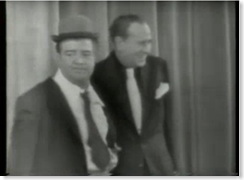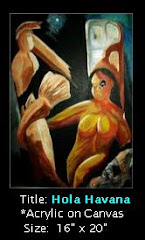"Anyone who knew Jackie Gleason in the 1940s," wrote CBS historian Robert Metz, "would tell you The Fat Man would never make it. His pals at Lindy's watched him spend money as fast as he soaked up the booze." - Wikipedia
Luckily, Jackie Gleason proved them all wrong.
But it took nearly a decade of work, in Hollywood and on Broadway, before he would finally become a success in show business.

Early on, Gleason worked as a contract player at Warner Brothers. He appeared in a handful of movies, often uncredited. His salary in 1941 at Warners was reportedly $250 a week.
In the mid-1940's Gleason would find more work, and success, on the Broadway stage and in night clubs. His big break came in the Broadway show Follow The Girls (1944).

Al Hirschfeld Promotional Caricature
Gleason would largely disappear from the national spotlight until late in the decade, working in night clubs, honing his comedic skills. All of that would change in 1949, when at the age of 33, Gleason landed the role of Chester A. Riley in television's Life of Riley.
The original Life of Riley, barely remembered today, was a summer replacement radio show on the CBS network, which had no real connection to the shows that would follow.
It starred Lionel Stander as J. Riley Farnsworth.
The Life of Riley as most people remember it, began in 1944 on the radio, and starred William Bendix. It would air first on the ABC network, but move to NBC in 1945. Proctor and Gamble (Prell Shampoo) and Pabst Blue Ribbon beer were its sponsors.
When the fledgling Dumont network decided to air Riley as situation comedy, a situation developed.
Bendix was prevented from accepting the role due to contractual conflicts with his movie studio.
Dumont needed a new Riley, and they went with the little known comedian Gleason.
The show wasn't a particularly good showcase for Gleason's talent, and worse, most of the country was still without television. The Dumont network, which operated on a shoestring budget, had very few broadcast outlets as well.
Gleason's run would last only one year.
(Bendix would head the cast of a revived version of The Life of Riley - the one most of us remember - on NBC starting in 1953, and running for 5 years).
Starring with Gleason were Rosemary DeCamp, Gloria Winters, Lanny Rees, Sid Tomack as Gillis, and John Brown as morbid undertaker and friend Digby (Digger) O'Dell.
We've a pair of rare early kinescope of Gleason as Riley, available on the Internet Archive. Certainly not Gleason's finest half-hour, but nostalgic, historic, and pleasant enough viewing.

![[movies]](http://www.archive.org/images/mediatype_movies.gif)
Tonsils
Life Of Riley EP--Tonsils
![[movies]](http://www.archive.org/images/mediatype_movies.gif)
French Professor
Life of Riley EP French_Professor
Gleason left the Life of Riley, feeling he could do bigger and better things. He would get another break in 1950 when Jerry Lester (I know, most people are saying "Jerry who?") abruptly quit his job hosting DuMont's Cavalcade of Stars show after only 4 months.
DuMont, desperate, offered Jackie Gleason a six-week contract.
Gleason would bringing many vaudevillian performers from New York to the show, along with dancing girls, raucous standup comedy, and comedic sketches and vignettes.
He was a huge hit. An overnight sensation, after a mere decade of performing.
Cavalcade of Stars quickly became DuMont's most popular show. Gleason would create many of his signature characters for this show, including Reginald Van Gleason III, Joe the Bartender, The Poor Soul, and the most famous of all . . . Ralph Kramden.
The Honeymooners would be Gleason's most enduring creation.
Few people today remember who played the original Alice Kramden - Pert Kelton - who left the show after being blacklisted during the McCarthy era. Younger audiences may remember her as Shirley Jones' mother in the movie, The Music Man.
Her absence was explained as due to `her health'.
We've an early sample of the Honeymooners with Pert Kelton as Alice, circa 1951. Art Carney and Joyce Randolph complete the cast. These shows were louder and harsher than the later ones with Audrey Meadows.

Jackie Gleason & Pert Kelton
This honeymooner's clip runs only about 9 minutes. Most of these shows are lost forever, as very few kinescopes were saved.
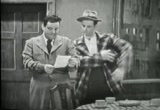
Jackie Gleason on "Cavalcade of Stars"
Jackie Gleason on the popular 50's TV series "Cavalcade of Stars", doing a sketch called "The Honeymooners", which was later turned into a sitcom. "Cavalcade of Stars" started in 1949 and quickly became one of the most popular shows on The DuMont Television Network.
Jackie Gleason would be enticed away from the struggling DuMont nework by CBS, offered a far bigger paycheck, and creative control in 1952. He would bring Art Carney, Audrey Meadows, Joyce Randolph, and the June Taylor dancers with him.
A footnote to history. Larry Storch (F Troop) was selected to carry on for DuMont after Gleason left the show. Gleason was a hard act to follow, and the show folded a few months later.
We've a brief clip from The Jackie Gleason Show, circa 1953, with a very young Frankie Avalon showing up The Great One.
Gleason, and his long-time sidekick Art Carney, would take a stab at a dramatic portrayal in Studio One's The Laugh Maker in 1953. Studio One was one of several quality anthology series featuring original screenplays performed live.
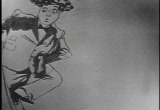
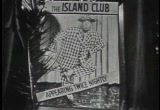
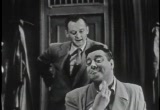
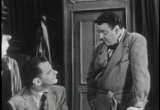
![[movies]](http://www.archive.org/images/mediatype_movies.gif)
The Laugh Maker
Studio One ep05x34 The Laugh Maker Jackie Gleason & Art Carney Star
A genuine departure for Gleason and Carney, but one that was well received by critics and the public alike.
By 1955 the Honeymooner's was such a popular segment on his variety show, Gleason suspended the regular format, and filmed the classic 39 episodes of the Honeymooners that would run in syndication for decades.
He would revive the variety format in 1956, but his show would end in 1957. He briefly appeared in a half-hour variety show, co-hosted by Buddy Hackett, in 1958.
It didn't last long.
In 1961, Gleason would return with an ill-conceived game show called You're In The Picture. It featured a celebrity panel that included Pat Harrington, Jr., Pat Carroll, Jan Sterling, and Arthur Treacher.
The opening show was so bad (how bad was it?). Gleason apologized for the entire second show. The format was abandoned, and Gleason fulfilled the rest of his contract doing a short-lived interview show.
Gleason would return to television, and begin a 8 year run, in 1962 with The American Scene Magazine variety show which aired from New York City the first two years, then moved to Miami Beach in 1964.
Back again would be The Honeymooners, Joe the Bartender, along with series regulars like Art Carney, and Sue Ann Langdon (playing Alice!), and Frank Fontaine as Crazy Guggenheim.
Perky 26 year-old Sue Ann Langdon, two decades years younger than Gleason, was an odd choice to play the long suffering Alice.
Quite honestly, she was too attractive, and too `perky' for the role.
Luckily, she was a versatile performer, and was given other duties during her stint on the show. She would go on to be an often cast performer on television, probably best remembered for the series Arnie with Herschel Bernardi and for a role on General Hospital.




![[movies]](http://www.archive.org/images/mediatype_movies.gif)
"Jackie Gleason and His American Scene Magazine" - Max Liebman
"Jackie Gleason and His American Scene Magazine" (1962) Original Air Date: 29 September 1962 (Season 1, Episode 1) Directed by Seymour Robbie Writing credits Jerry Bresler writer Coleman Jaacoby writer Terry Ryan writer Saul Turteltaub writer Produced by Max Liebman .... coordinating producer Cast (Episode Credited cast) Art Carney ... Ed Norton Wayne Newton Series Cast Jackie Gleason ... Himself - Host Frank Fontaine .....
The opening comedy sketch, a parody of The Untouchables, was pretty lame . . . although it gave leggy Sue Ann Langdon a nice part to play.
Things improve with the Joe the Bartender Sketch (Frank Fontaine doesn't sing in this one . . .a pity). The big highlight comes about halfway through the show.
The first national appearance by an unknown act.
The Newton Brothers.
As in Wayne Newton. Age 20, playing the Banjo and singing up a storm. This is television magic. Worth the price of admission on its own.
There is simply no other way to describe it.
This appearance, on September 29th, 1962 would propel Wayne Newton into stardom. Gleason would have Newton return a dozen times over the next two years. Lucille Ball, Bobby Darin, Danny Thomas, George Burns, and Jack Benny would all support this young singer's rise to stardom.
The show ends with a Honeymooner's sketch, and after a slow start, it too becomes a laugh riot. Alice and Trixie aren't given much to do in this episode, but it is classic Norton and Kramden.
The later Gleason shows are, as far as I know, not public domain. Hopefully some more of his earlier work will be made available.
Gleason would see his career expand into dramatic roles in the Movies, earning an Academy Award nomination for his portrayal of Minnesota Fats in The Hustler, and acclaim playing the boxing manager in Rod Serling's Requiem For A Heavyweight.
Gleason died in 1987, in the end suffering from liver and colon cancer. He was a heavy smoker, consuming as many as six packs a day. He was 71 years old.
Thankfully, as long as we have his films, his legacy lives on.





![[movies]](http://www.archive.org/images/mediatype_movies.gif)

















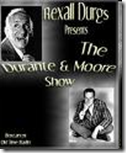
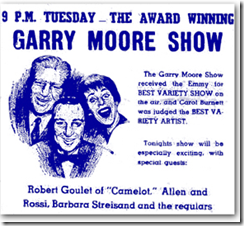
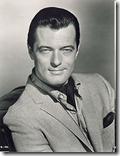
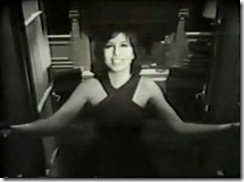


![[audio]](http://www.archive.org/images/mediatype_audio.gif)










